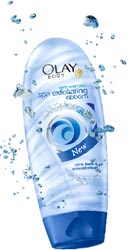Scrubbing Out Sea LifeExfoliating plastic beads feel good—unless you live in the ocean.
By Hillary Rosner
Posted Monday, June 16, 2008, at 2:45 PM ET
 Is your exfoliant harming marine life?
Is your exfoliant harming marine life?
A smiling model glides, mermaidlike, through a lush underwater garden. Undulating ribbons of something resembling kelp rise from the sea floor, and tiny enchanting pearl-like beads bubble up though the aquamarine water. Polish your troubles away with
Olay Body Wash Plus Spa Exfoliating Ribbons, the subject of this commercial, and you too might feel as if you’re floating through a luxurious Atlantis.
The trouble is, the more you exfoliate, the less Edenic that underwater realm becomes for the creatures who live there. That’s because the exfoliating ingredient in Olay’s body wash, and in most similar big-brand products (such as
Dove Gentle Exfoliating Foaming Facial Cleanser and
Clean & Clear Daily Pore Cleanser), is actually made out of plastic: tiny particles of polyethylene that scrub the dirt from your face and then wash straight down the drain and into watersheds and, eventually, oceans.
It’s well-known by now that increasing amounts of plastic are
clogging the planet’s seas, killing millions of sea creatures every year when they swallow it, choke on it, or get tangled in it and drown. Plastic doesn’t biodegrade, meaning it doesn’t break down into its initial components; every piece of plastic ever made is probably still around somewhere on the planet today. But sunlight disintegrates plastic into smaller pieces of plastic. These can wind up in waterways like rivers and creeks, flowing out to sea.
The thing about plastic exfoliating beads is that they don’t need to break down in order to end up in the stomachs of marine life from otters to octopi.
"As this debris occupies the same size range as sand grains and planktonic organisms, it is available to a wide range of invertebrates near the base of the food chain," says Mark Browne, a scientist at the Centre for Ecological Impacts of Coastal Cities at the University of Sydney who has studied the consequences of microscopic plastic in marine habitats. And unlike other types of plastic that just happen to end up in the ocean, these beads are almost predestined to reach the sea.
The amount of "
microplastic"—fragments smaller than 1 millimeter—in the oceans has "increased significantly" over the last few decades, according to Browne, who found that 85 percent of the plastic debris in one British estuary was micro. Browne believes that one reason more people haven’t heard about the problem is simply that it’s difficult to study. "Quantifying tiny plastic fragments in the animal tissues presents a number of methodological challenges," he says.
Still, laboratory experiments have shown that a range of bottom-of-the-food-chain critters—including mussels, barnacles, lugworms, and tiny crustaceans called amphipods—will ingest the particles, which may then remain in their digestive tracts or migrate to other body tissue.
New research also suggests that polyethylene is an excellent transporter of phenanthrene, a byproduct of fossil fuel burning that’s a dangerous ocean pollutant.
Jay Gooch, associate director of external relations in beauty care at
Procter & Gamble, Olay’s parent company, says the total volume of the microbeads is too small to have an impact—though he did not respond to an e-mail asking how many Olay products contain them and the number of those products sold annually.
"Our assessment is that they will largely be removed during sewage treatment," says Gooch, who has a Ph.D. in toxicology and did his postdoctoral research at the Woods Hole Oceanographic Institution. "We’re talking about very small amounts, so the overall loading from these things is very small even compared to the main ingredient in a laundry detergent, say."
But sewage treatment systems are not designed to remove microplastic, meaning the particles are likely to remain in the water. "It would appear that considerable quantities of these materials may be entering aquatic habitats; little is known about their persistence or the potential environmental consequences and more work is needed to establish this," Browne says.
Not all exfoliants contain plastic. Many products are available that use salt, pumice, or ground up seeds to do the same job without the environmental cost—like
Burt’s Bees Deep Pore Scrub (finely ground peach stones) or
St. Ives Apricot Scrub (apricot kernels). So why doesn’t Olay? "I’m a firm believer that just because it’s natural doesn’t mean it’s benign," Gooch says. That’s undeniably true. It’s also true that just because it’s advertised using tranquil ocean imagery doesn’t mean it’s good for marine life.